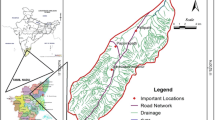Abstract
The paper examines relative performance of six monthly rainfall-runoff models on 12 catchments located in different agro-climate zones of Central India. Study indicates that a water balance type model can reproduce the catchment behaviour in a better manner as compared to a statistical model and it is easier to model runoff for catchments with higher runoff factor. Also, a two-parameter model is found sufficient to represent the rainfall-runoff relationship of the catchment on a monthly scale.
Similar content being viewed by others
References
Beven, K.: 1989, Changing ideas in hydrology: the case of physically-based models, J. Hydrol. 105, 157–172.
Blackie, J. R. and Eles, C. W. O.: 1985, Lumped catchment models, In: M. G. Anderson and T. P. Burt (eds), Hydrological Forecasting, Wiley, New York.
Chiew, F. H. S., Stewardson, M. J. and McMahon, T. A.: 1993, Comparison of six rainfall-runoff modelling approaches, J. Hydrol. 147, 1–36.
Ciriani, T. A., Maione, U. and Wallis, J. R.: 1977, Mathematical Models for Surface Water Hydrology, Wiley, Chichester.
Hooper, R. P., Stone, A., Christophersen, N., de Grosbois, E. and Seip, H. M.: 1988, Assessing the Birkness model of stream acidification using a multisignal calibration methodology, Water Resour. Res. 24, 1308–1316.
Ibbitt, R. P. and O'Donnell, T.: 1971, Fitting methods for conceptual catchment models, J. Hydraul. Div. ASCE (HY9), 1331–1342.
Jakeman, A. J. and Hornberger, G. M.: 1993, How much complexity is warranted in a rainfall-runoff model, Water Resour. Res. 29, 2637–2649.
Littlewood, I. G. and Jakeman, A. J.: 1992, Hydrograph seperation into dominant quick and slow flow components, In: Third National Hydrology Symp., Br. Hydrol. Soc., Univ. of Southampton, England.
Loague, I. G. and Freeze, R. A.: 1985, A comparison of rainfall-runoff modelling techniques on small upland catchments, Water Resour. Res. 21, 229–248.
L'vovich, M. I.: 1979, World Water Resources and Their Future, Original in Russian, English translation, American Geophysical Union.
Moore, I. D. and Mein, R. G.: 1975, An evaluation of three rainfall-runoff models, Proc. Hydrol. Symp., Sydney, May 1995, Inst. Engng. Aust. Sydney, N. S.W., Nat. Conf. Publ., 75/3, pp. 122–126.
Rosenbrock, H. H.: 1960, An automatic method for finding the greatest or least value of a function, Computer J. 3, No.175.
USDA, SCS: 1985, National Engineering Handbook, Section 4: Hydrology, Soil Conservation Service, Washington, D.C.
Weeks, W. D. and Hebbert, R. H. D.: 1980, A comparison of rainfall-runoff models, Nordic Hydrol. 11, 7–24.
World Meterological Organisation: 1975, Intercomparison of conceptual models used in operational hydrologic forecasting, Operational Hydrol. Rep. 7, WMO, Geneva.
World Meteorological Organisation: 1986, Intercomparison of models of snowmelt runoff, Operation Hydrol. Rep. 23, WMO 646, Geneva.
Author information
Authors and Affiliations
Rights and permissions
About this article
Cite this article
Mehrotra, R., Singh, R.D. The Influence of Model Structure on the Efficiency of Rainfall-Runoff Models: A Comparative Study for Some Catchments of Central India. Water Resources Management 12, 325–341 (1998). https://doi.org/10.1023/A:1008052009729
Issue Date:
DOI: https://doi.org/10.1023/A:1008052009729




